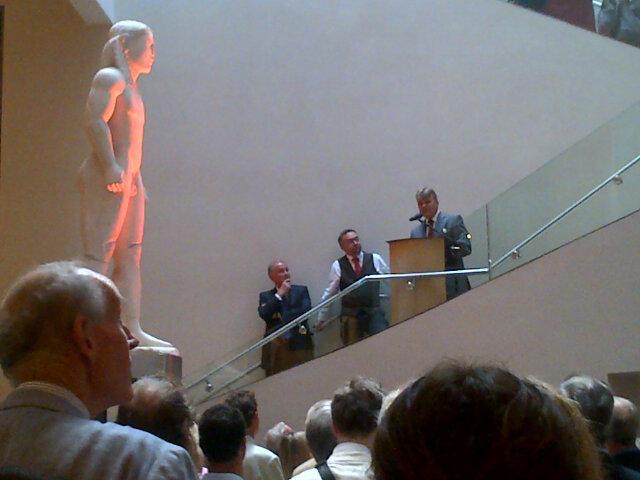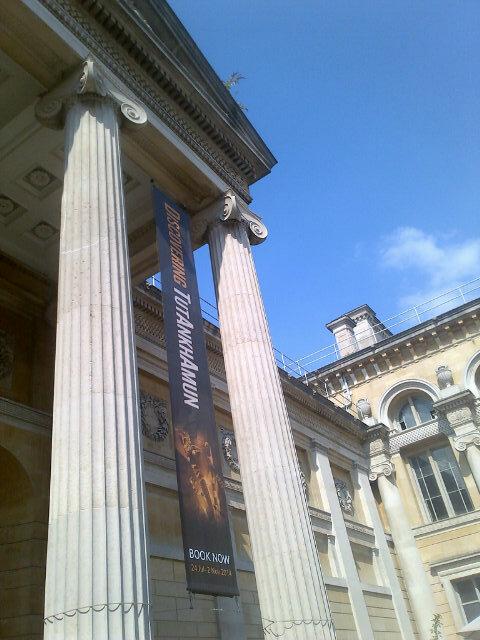'There is only one topic of conversation... one cannot escape the name of Tut-Ankh-Amun anywhere...'
New York Times, 1923
I had the pleasure of attending the private view of the 'Discovering Tutankhamun' exhibition at the Ashmolean Museum yesterday; a major Egyptological event which delighted the media and the hundreds of guests who enjoyed the great hospitality of the Museum as well as a sneak-peak at the Museum's summer exhibition.
The exhibition was officially opened by the 8th Earl of Carnarvon, whose rousing speech followed those of Christopher Brown (Ashmolean Director) and Prof. Richard Parkinson (Professor of Egyptology, University of Oxford).
 On entering the exhibition the visitor is introduced to a gallery space showcasing Howard Carter
On entering the exhibition the visitor is introduced to a gallery space showcasing Howard Carter and
his work in Egypt before the discovery of Tutankhamun's tomb - the project which subsequently became his life's pursuit. A personal favourite is a famous painting from Carter's work at the temple of Hatshepsut at Deir el-Bahri in Thebes showing a beautifully reproduced Horus falcon.
The background setting moves rapidly into the wonderful discovery, told through diary entries and correspondence, which Carter made on November 4th 1922 - the first step leading down to the tomb, which he and the 5th Earl of Carnarvon entered three weeks later.
The beauty of the exhibition is that it tells the story of the discovery by intertwining ancient and contemporary objects with rare archive material from the Griffith Institute, and in doing so effectively illustrates the different stages of discovery, study and conservation, and ultimately the painstaking removal of the many hundreds of objects from the tomb, not to mention the politics associated with such an overwhelmingly vast task.
This technique of display highlights the different roles of those individuals involved in the project - artists, conservators, linguists, scientists, and photographers: the products of Harry Burton's pioneering photographic work in particular formed impressive backdrops to the gallery. I was pleased to see Griffith archive material that I'd never seen before, including beautiful and incredibly detailed artwork of some of the finds from the tomb by Nina de Garis Davies and Winifred Brunton.
The exhibition then transports the visitor back in time to the 1920s, when 'Tut-Mania' took over the world. This immersive experience includes cases full of Egyptianising and Tut-inspired products from the UK and beyond, including a Cartier brooch in the form of a winged scarab and some tiny ladies' gloves embroidered with ancient Egyptian hieroglyphs, all while listening to the original recording of 'Old King Tut' by William Jerome and Harry von Tilzer from the height of Tut-Mania in 1923.
It was also fascinating to see the general public's reception of the great discovery - from letters written to Carter asking for 'souvenirs' from the tomb, to those wishing him luck and giving him tips on how to avoid the 'Curse of the Pharaoh' which had already 'claimed' Lord Carnarvon. Contemporary newspaper articles are also on display, alongside Carter's wooden cabinet full of slides which he used to present the incredible story of his discovery to an insatiable public.
 The exhibition concludes with an overview of Tutankhamun's historical context: the Amarna Period and it's aftermath. Here I was delighted to see objects from Berlin and the Metropolitan Museum which I'd never seen before, as well as large-scale British Museum sculpture in a new display context including a statue of Tutankhamun as a priest of the god Hapy, likely from Karnak (EA 75). My only issue with this display is that the complex history of the period is somewhat condensed in order to fit into that space, but of course if the visitor would like to know more then they can certainly fill their boots in the excellent Amarna Period section of the Museum's newly-redisplayed Egypt and Sudan gallery downstairs.
The exhibition concludes with an overview of Tutankhamun's historical context: the Amarna Period and it's aftermath. Here I was delighted to see objects from Berlin and the Metropolitan Museum which I'd never seen before, as well as large-scale British Museum sculpture in a new display context including a statue of Tutankhamun as a priest of the god Hapy, likely from Karnak (EA 75). My only issue with this display is that the complex history of the period is somewhat condensed in order to fit into that space, but of course if the visitor would like to know more then they can certainly fill their boots in the excellent Amarna Period section of the Museum's newly-redisplayed Egypt and Sudan gallery downstairs.
 As you might tell there is far too much for me to fit into one post and this is really only skimming the surface of an exhibition truly full of 'wonderful things'; things which have been successfully curated to make the story of 'Discovering Tutankhamun' appeal to the widest possible audience, whilst including all of the finer details necessary for a nuanced discussion of the discovery.
As you might tell there is far too much for me to fit into one post and this is really only skimming the surface of an exhibition truly full of 'wonderful things'; things which have been successfully curated to make the story of 'Discovering Tutankhamun' appeal to the widest possible audience, whilst including all of the finer details necessary for a nuanced discussion of the discovery.
I'd like to extend grateful thanks to the Ashmolean Museum, and to Liam McNamara for the opportunity to attend the Private View. I look forward to attending the exhibition events due to run over the coming months (the exhibition runs from 24 July 2014 to 2 November 2014) - in the meantime follow #DiscoverTut to find out more and see the exhibition trailer here.
 I'm back in London and happily reviving my discoveries of Egyptianising architecture in the city. This week I was walking down Mornington Crescent with friends when something caught my attention, and as a result I was completely soaked by a passing bus veering through a huge puddle! Nevertheless my spirits weren't too dampened since that distraction was in fact the wonderful old Carreras Cigarette Factory in Camden, now Greater London House.
I'm back in London and happily reviving my discoveries of Egyptianising architecture in the city. This week I was walking down Mornington Crescent with friends when something caught my attention, and as a result I was completely soaked by a passing bus veering through a huge puddle! Nevertheless my spirits weren't too dampened since that distraction was in fact the wonderful old Carreras Cigarette Factory in Camden, now Greater London House.  This building is another incredible illustration of the early 20th century vogue for Egyptianising architecture in London, much like the Carlton Cinema on Essex Road, juxtaposing 'traditional' ancient Egyptian temple elements in a distinctive Art Deco design. It was erected in 1926-28 by the Carreras Tobacco Company and the original design included an ornamental winged solar disk and two colossal seated bronze cat statues flanking the entrance in the form of the cat goddess Bastet. Carreras used the black cat as a marketing device; their cigarette packets also included a similar image. The main facade of the building was composed of a row of twelve brightly-painted papyriform columns and the handrails of the main entrance took the form of serpents. The outer ornamental railings incorporated a series of hieroglyphic motifs including the djed-pillar and decorative lotiform elements.
This building is another incredible illustration of the early 20th century vogue for Egyptianising architecture in London, much like the Carlton Cinema on Essex Road, juxtaposing 'traditional' ancient Egyptian temple elements in a distinctive Art Deco design. It was erected in 1926-28 by the Carreras Tobacco Company and the original design included an ornamental winged solar disk and two colossal seated bronze cat statues flanking the entrance in the form of the cat goddess Bastet. Carreras used the black cat as a marketing device; their cigarette packets also included a similar image. The main facade of the building was composed of a row of twelve brightly-painted papyriform columns and the handrails of the main entrance took the form of serpents. The outer ornamental railings incorporated a series of hieroglyphic motifs including the djed-pillar and decorative lotiform elements. The official opening of the building was a grand event, including a procession of cast members from the contemporary theatrical production of Aida and a chariot race on Hampstead Road. It has since been argued that this design may have been deliberately chosen by the company in order to associate their cigarettes with the glamour and luxury of ancient Egypt.
The official opening of the building was a grand event, including a procession of cast members from the contemporary theatrical production of Aida and a chariot race on Hampstead Road. It has since been argued that this design may have been deliberately chosen by the company in order to associate their cigarettes with the glamour and luxury of ancient Egypt. 


